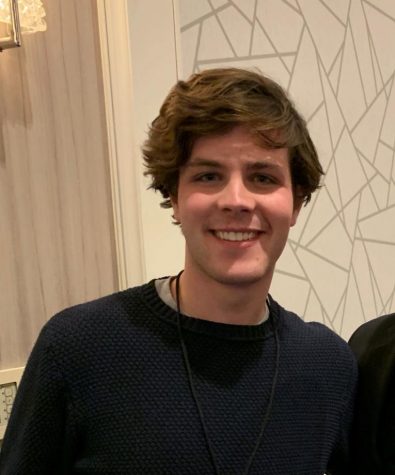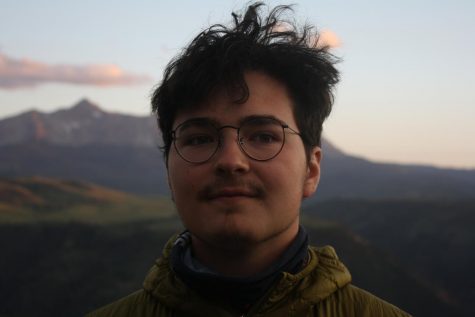Forest the Quad
San Francisco State University’s forest quad.
Nov 4, 2021
John Carroll would not be the same without its trees. What if they were all gone?
Imagine no tree cover: the beating, unfiltered, blistering summer sunlight; the unrestrained, unrepentant, monsooning spring rainfall. Forget the hammockers, the red-gold fall, the lush green summer. Erase the squirrels, the blue jays and the robins.
The trees of JCU are giant ghosts. Hiding in plain sight, they shape each of our fundamental relationships to this place. I’d be the first to admit that I rarely acknowledge these ghosts on my way to and from class. Yet, if, as I passed beneath the arches of Admin, the trees were to suddenly vanish, I’d certainly wish I had the chance to say goodbye. I’d instantly be met with a barren and empty Quad –– no squirrels to stare at me, no birds to sing for me, no friends to hammock with me.
The trees are as central to this community as you are. Whether we realize it or not, their presence or absence totally alters our perception of and interaction with a place –– a field is a very different thing than a forest. And I, for one, prefer the forest.
So, I write today with a humble proposal: cover the entire Quad in trees. Forest the Quad.
I hear the objections now. “Where will we play Spikeball? How will we be able to spot and shame Quad-crossing freshmen?”
The answer lies on the other side of Admin: Hamlin Quad. How lucky are we to have two, perfectly good quads on our small campus. Hamlin Quad can remain simply tree-lined. The main Quad will be forested.
What justifies such a radical re-landscaping? Beyond the aesthetic and hammocking-utility of a tree, I can think of two slightly more serious reasons.
First, a forest is healing. And I don’t mean in a hippie, tree-hugger kind of way…though that I may be. Rather, I mean that in a scientific, Harvard Medical School kind of way. There is a growing body of research investigating the profound health benefits walking in a forest provides. It decreases cortisol levels, which can help lower blood pressure and prevent heart disease. Exposure to antimicrobial agents from trees may also boost your immune system. And that doesn’t even begin to touch on the psychological effects contact with nature can have on a person. Providing students easy access to a forest will almost certainly offer real health benefits for the community.
Second, what Emerson might call the moral analogy of nature is worth considering. In every tree is a tall, leafy, stoic symbol. These are the classic virtues ascribed to trees. They are wise in their age, fortuitous in their staying power, humble in their stillness. Cutting-edge ecological research teaches us still more about these beasts’ virtue. Recent findings suggest that trees shift nutrients among each other through underground networks of fungal and microbial connections. Put in human terms, they share. We have much to learn from these arboreal ghosts.
But, beyond the moral analogy of a tree itself, in the very planting of a sapling, I think, contains a more moving, more prescient moral teaching. If we were seriously to forest the Quad –– a feat I assure you, dear reader, would be completed by year’s end if it weren’t for budgetary hardship –– it would take decades for the full, thriving forest to begin to emerge. None of us students, and perhaps only a handful of young faculty, would be around to reap its benefit. Except as a visiting Alumni, I would never get to wander JCU’s central park.
There is a sacrifice, a dedication realized by such a project. The forested Quad would not be for us: it would be for the next generation of JCU students.
They will almost inevitably face warmer temperatures, flooding, drought and other severe weather events. This is a consequence of a climate in crisis; a crisis that is of our doing. The least we can do is build them a forest.
Do it for the marginal environmental benefit of a hundred new trees, sure. But do it most of all to build our future classmates a place to call home –– a leafy maze to walk in, a shaded wood to hammock in, a blissful scene to seek serenity in, a winter wonderland to jaunt in.
Finally, in literally planting the seeds (or saplings) for such a new home, let us not miss the obvious moral analogy present for us: we are only visitors here. We call JCU home for four short years, this earth home for seven or eight (nine or 10, if we’re lucky) short decades, and then we leave. The work we do now is not for us. It is for those who come after us.
I think it fitting that a Jesuit educational institution, whose mission is to unflinchingly seek truth and boldly share it with the world, ought to construct a living, breathing monument to this truth.
Forest the Quad.















Jeff Your • Nov 22, 2021 at 9:04 am The Carroll News Pick
The Sustainability Committee fully supports all ideas to make our campus more “green” and more green. We commend this idea to the Facilities Dept for serious consideration.
Many years ago, there were three large weeping willow trees near Dolan Hall on the main quad. Those three trees were sufficient to keep the quad dry for commencement. Even trees have a lifetime and theirs were nearing the end. Rather than risk the damage or injury a large limb falling might produce, they were removed.
Our campus-wide arboretum currently contains over 1,000 trees representing nearly 90 species. We propose to set a short term goal of achieving representation of more than 100 species and a long-term goal of sustained growth in species diversity. In pursuit of this goal, the Sustainability Committee wishes to focus our acquisitions and nurturance of new trees on campus toward species that are:
1. native to Ohio, or
2. resilient and well-adapted to the Northeast Ohio climate, if not historically native, and
3. will add diversity to our arboreal catalog, are disease-resistant, or especially well-suited to our soil and water profile, which
4. demonstrate pedagogical value, and
5. increase the overall beauty of campus throughout the year
Carrie Buchanan • Nov 19, 2021 at 11:40 pm
I love this idea! Nicely written, too!